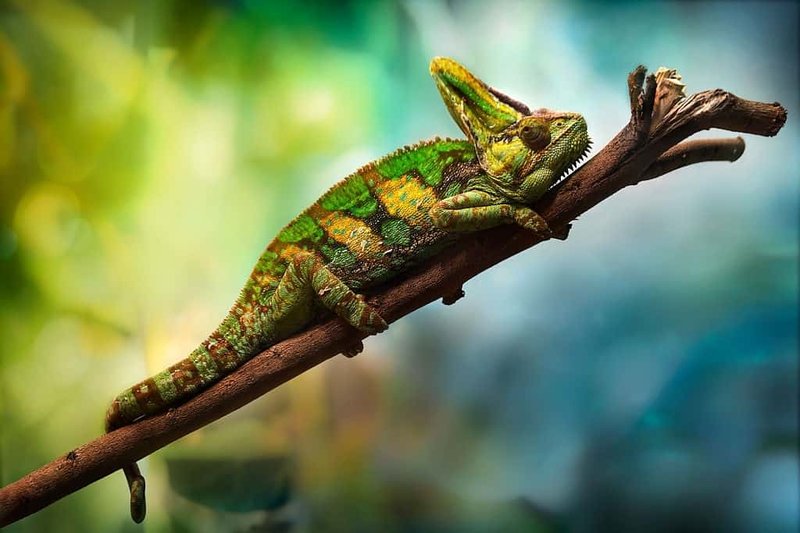
Chameleons are much more than their color-changing abilities; they’re fascinating creatures with unique behaviors and needs. Let’s dive into some common myths and facts about chameleons so you can impress your friends at your next coffee chat! Plus, you’ll get a better understanding of what makes these tiny wonders tick.
Myth 1: Chameleons Change Color to Blend In
You might be surprised to learn that while chameleons do change color, it’s not just to camouflage themselves. Here’s the thing: they primarily change color for communication and temperature regulation. Imagine if you wore different outfits depending on your mood or the weather—this is similar to how chameleons operate.
When a chameleon is feeling stressed, angry, or threatened, it might shift to darker colors. On the flip side, a relaxed chameleon may flaunt brighter hues. This color-changing ability is fascinating, isn’t it? It’s also worth noting that their environment plays a role, so factors like lighting and background can affect their color, too.
The Real Reason Behind Color Change
Color change serves to show emotions, attract mates, and assert dominance over other chameleons. For example, during mating season, males display vibrant colors to attract females, while duller colors signal submission. So, if you thought they were masters of disguise, you’re partly right—but there’s much more going on beneath the surface!
Myth 2: All Chameleons Are the Same Size
Another common misconception is that all chameleons are tiny, pocket-sized lizards. Sure, many species are small, but others can be surprisingly large. For instance, the Parson’s chameleon can reach lengths of up to two feet! That’s like having a small dog hanging out in your living room.
Chameleons come in a variety of sizes, colors, and appearances. Some are vibrant and flamboyant, while others are subtler in hue. Knowing the different types can help you appreciate their diversity.
Popular Species and Their Sizes
Here’s a quick rundown of a few common chameleon species and their typical sizes:
- Veiled Chameleon: 12-24 inches
- Panther Chameleon: 10-20 inches
- Jackson’s Chameleon: 5-15 inches
- Parson’s Chameleon: Up to 24 inches
Myth 3: Chameleons Have Long, Sticky Tongues for Catching Prey
While it’s true that chameleons are known for their long tongues, the sticky factor isn’t just a neat trick—they’re a crucial part of their hunting strategy. The tongue can extend to twice the length of their body, allowing them to snag insects from a distance. It’s almost like having a superhero arm that can stretch!
When a chameleon spots a meal, it will shoot its tongue out with incredible speed. This action creates a vacuum that helps secure the food, making it one of the most efficient hunters in the animal kingdom.
The Mechanics of the Chameleon’s Tongue
The way chameleons can project their tongues is nothing short of amazing. The tongue has a sticky tip that adheres to their prey, allowing them to reel it in effortlessly. It’s like having an elastic band that snaps back once it catches something!
Myth 4: Chameleons Can’t See Very Well
You might have heard that chameleons have poor vision, but that couldn’t be further from the truth. In reality, their eyesight is exceptional! They have the ability to see in full color and can even spot ultraviolet light, which is invisible to the human eye.
Chameleons have bulging eyes that can move independently of each other. This means they can watch for predators while hunting for food—talk about multitasking!
How Chameleons Use Their Vision
Their keen eyesight is a significant advantage in the wild. It helps them spot insects hiding among leaves or see potential threats in their environment. This visual prowess is vital for their survival, especially in the ever-changing habitats they occupy.
Myth 5: Chameleons Make Good Pets
Many people are drawn to chameleons because of their unique appearance and fascinating behaviors. However, keeping a chameleon as a pet isn’t as simple as it seems. Here’s the thing: these reptiles have specific needs that can be tough to meet, especially for beginners.
Chameleons require a carefully controlled environment, including humidity levels, temperatures, and proper UV lighting. If their habitat isn’t just right, they can become stressed or ill.
Setting Up the Perfect Habitat
Creating an ideal home for a chameleon involves more than just a cool tank. You’ll need to consider:
- Temperature gradients (basking and cooler areas)
- Humidity levels (often around 50-70%)
- Proper UVB lighting
- Live plants for climbing and hiding
If you’re seriously thinking about a chameleon as a pet, make sure to do your research first. They can be a rewarding challenge, but they’re not for everyone!
Chameleons are undoubtedly fascinating creatures, full of surprises that defy our expectations. By separating myths from facts, we gain a deeper appreciation for these unique reptiles. So, next time someone mentions chameleons, you’ll have a wealth of knowledge to share—like how they change colors for communication, their impressive size variety, and the challenges of keeping them as pets.
Remember, while chameleons might seem like magical creatures, there’s real science behind their behaviors and traits. And that makes them even more interesting!

